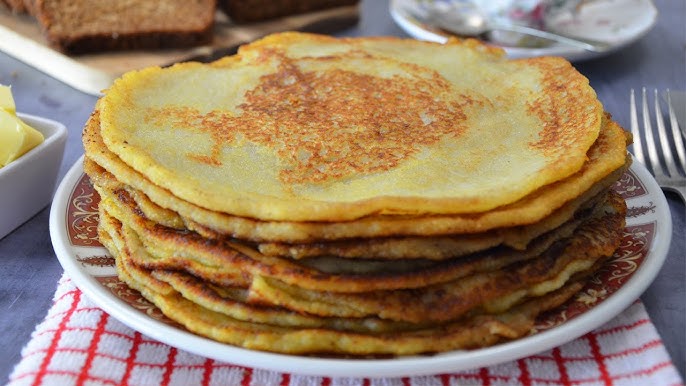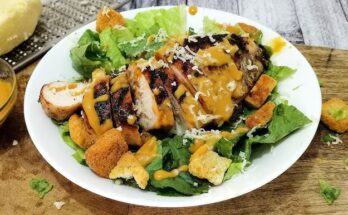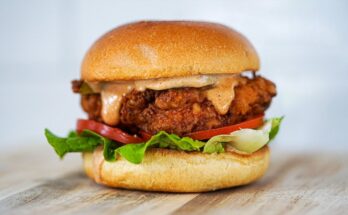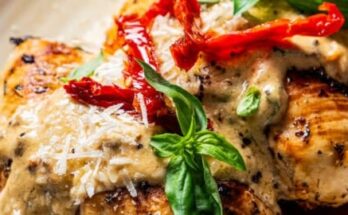Boxty Recipe: Have you ever taken a bite of something so comforting and nostalgic that it feels like a warm hug from grandma? That’s Boxty for you. Boxty is a traditional Irish potato pancake that’s been a staple of rural kitchens for generations. With its crispy edges and soft, fluffy interior, it’s the kind of dish that turns a simple potato into a celebration of home-cooked goodness.
Whether served as a breakfast treat, a savory side, or the main star of your dinner plate, Boxty has earned its place in Irish culinary heritage. It’s the ultimate comfort food that brings people together—perfect with a dollop of butter, sour cream, or even a side of smoked salmon.
Today, we’re diving into the heart of Irish kitchens to learn how to make Boxty from scratch. It’s simpler than you think, and once you’ve mastered the basics, you can play around with variations and flavors. Ready to get started?
What is Boxty?
Boxty, or “bacstaí” in Irish, is more than just a potato pancake—it’s a slice of history. This humble dish dates back centuries and was especially popular in the poorer regions of Ireland where potatoes were a dietary mainstay. Its popularity soared during the 18th and 19th centuries, especially in counties like Leitrim, Mayo, and Donegal.
The name “Boxty” comes from the Irish phrase arán bocht tí, which means “poor-house bread.” Despite its humble origins, Boxty has held strong through time and is now cherished not just for its taste but also for its cultural resonance.
Traditionally, Boxty is made from a mixture of grated raw potatoes and mashed cooked potatoes. The mix is combined with flour and buttermilk, then fried on a griddle or in a pan like pancakes. There are also regional variations like baked Boxty (more like a loaf) and Boxty dumplings. But the pan-fried version is by far the most popular.
What makes Boxty stand out is its texture—it’s crisp on the outside, soft and pillowy inside, and rich with the earthy flavor of potato. It’s traditionally served alongside bacon, eggs, or even meat stews, but it’s also delicious all by itself.
Ingredients You’ll Need
Basic Ingredients for Classic Boxty
Here’s what you’ll need to make a traditional batch of Boxty:
- 2 cups grated raw potatoes – peeled and finely grated.
- 1 cup mashed potatoes – ideally leftover, but freshly mashed works too.
- 1 cup all-purpose flour – for structure.
- 1 teaspoon baking soda – helps it puff up slightly.
- 1 teaspoon salt – to enhance flavor.
- 1 cup buttermilk – for moisture and tang.
- Butter or oil – for frying.
These ingredients are pantry staples, so you may already have most of them at home. The combination of raw and mashed potatoes gives Boxty its unique texture—grated potatoes add crispiness, while mashed bring softness.
Optional Add-ons and Variations
Want to spice things up? Consider adding:
- Chopped chives or green onions – for a savory kick.
- Grated cheese – cheddar adds richness.
- Crispy bacon bits – for texture and saltiness.
- Black pepper or garlic powder – to boost flavor.
- Fresh herbs like thyme or parsley – if you want something fragrant.
These additions are not traditional but are becoming popular in modern takes on the dish.
Choosing the Right Potatoes
This isn’t the time for fancy waxy potatoes. What you want is a high-starch potato, like:
- Russet potatoes (U.S.)
- Maris Piper (U.K./Ireland)
Starchy potatoes absorb less moisture and give Boxty that fluffy center and crispy finish. Avoid red or new potatoes—they’re too waxy and will make the batter too wet.
Kitchen Tools You’ll Need
Before you start, gather the right tools:
- Box grater or food processor – for grating potatoes.
- Cheesecloth or clean kitchen towel – for squeezing moisture.
- Mixing bowls – for combining ingredients.
- Measuring cups and spoons – accuracy matters.
- Non-stick skillet or cast-iron pan – for frying.
- Spatula – for flipping pancakes.
Having everything ready will make the process smooth and stress-free.
Step-by-Step Guide to Making Boxty
Step 1: Peel and Grate Raw Potatoes
First things first—grab your potatoes, peel them, and grate them finely using a box grater or a food processor. This is where Boxty gets its signature texture. You want your raw potatoes to be grated thin, almost like a hash brown consistency but a little finer.
Pro Tip: As soon as you start grating, the potatoes will begin to oxidize and turn brown. To slow this down, place them in a bowl of cold water while you grate the rest. Once you’re done, drain the grated potatoes and move on to the next step.
This part can get a little messy, but it’s totally worth it. Think of it as building the foundation for the best Irish pancakes you’ll ever eat. The finer the shred, the better the final texture.
Step 2: Squeeze Out Excess Moisture
Once your potatoes are grated, it’s absolutely essential to remove as much moisture as possible. Wrap the grated potatoes in a clean kitchen towel or cheesecloth and twist tightly to wring out all the liquid. You’ll be surprised how much water comes out—potatoes hold a lot of it!
Why is this step important? Too much moisture means soggy Boxty. We’re going for golden, crispy outsides and soft, warm insides. Excess water will ruin that balance. So don’t skip this—squeeze like your crispy edges depend on it. Because they do.
Step 3: Boil and Mash Additional Potatoes
While you’re prepping your raw potatoes, you can simultaneously boil a few peeled potatoes to mash. You’ll need about 1 cup of mashed potatoes for the recipe.
Cook them until fork-tender, then mash them with a little bit of butter (optional, but delicious). You want them smooth, not lumpy. The mashed potatoes are what help give Boxty its fluffy center, and they also act as a natural binder, holding everything together beautifully.
If you have leftover mashed potatoes from another meal—this is a great way to use them up. Just make sure they’re not overloaded with cream or seasoning.
Step 4: Combine Raw and Mashed Potatoes
Now for the fun part—combining both types of potato. In a large mixing bowl, add your grated (and squeezed-dry) raw potatoes and mashed potatoes. Mix them gently with a wooden spoon or spatula until well combined.
The idea here is to create a cohesive potato base that has both texture and softness. The raw potatoes will provide that satisfying crunch after frying, while the mashed ones give the pancakes their structure and heartiness.
You’ll already start to notice how “pancake batter” this mix is starting to feel, but hang tight—there are a few more ingredients to bring it all together.
Step 5: Add Flour, Baking Soda, and Salt
Time to introduce your dry ingredients. Sprinkle in:
- 1 cup of all-purpose flour
- 1 tsp baking soda
- 1 tsp salt
Mix everything together until the flour is evenly distributed. The flour helps bind the mixture and gives it that golden crust when cooked. Baking soda, meanwhile, reacts with the acidity of the buttermilk (coming up next) to add a little lift to your pancakes—this makes them lighter and fluffier.
Be sure not to overmix here. You want the ingredients well incorporated but still light. Overworking the mixture can make it dense.
Step 6: Add Buttermilk to Create Batter
Pour in about 1 cup of buttermilk, a little at a time, and stir to combine. The amount may vary slightly depending on how moist your potatoes were, so keep an eye on the consistency.
You’re aiming for a thick, scoopable batter—think slightly thicker than pancake batter. Not too runny, not too dry. If it’s too thick, add a splash more buttermilk. If it’s too wet, a tablespoon of flour will help balance it out.
Buttermilk is a key player here. It adds tang, enhances the flavor, and helps with browning. If you don’t have buttermilk, you can DIY it: just add 1 tablespoon of lemon juice or vinegar to a cup of regular milk and let it sit for 5–10 minutes.
Step 7: Mix Until Smooth
Now that all your ingredients are in the bowl, give everything a good mix until you have a smooth, cohesive batter. This shouldn’t take more than a minute or two.
You don’t want to see clumps of flour or uneven potato pieces. The smoother the batter, the more evenly your Boxty will cook. At this point, it should feel like a thick pancake batter with visible shreds of potato running through it.
Set the batter aside for 5–10 minutes while you heat your pan—this allows the ingredients to settle and lets the flour hydrate properly.
Step 8: Heat the Pan with Butter or Oil
Grab a heavy-bottomed skillet (cast iron is perfect) and place it over medium heat. Add a generous amount of butter, oil, or a mix of both. The fat not only prevents sticking but also helps create that golden crust we’re after.
Let the butter melt and sizzle slightly—but don’t let it burn. You want the pan hot enough so that the batter starts to sizzle as soon as it hits the surface, but not so hot that it scorches.
Use a paper towel to gently spread the oil evenly across the pan, making sure it’s well-coated.
Step 9: Fry the Boxty Pancakes
Now, it’s go time.
Scoop about 1/4 cup of the batter and gently spread it into the pan, shaping it into a small pancake about 4 inches across and ½ inch thick. Don’t overcrowd the pan—leave enough space to flip them easily.
Cook for 3–5 minutes per side, or until golden brown and crispy. Use a spatula to gently flip them—if they’re sticking, they’re not ready yet, so give them another minute.
Once both sides are beautifully browned, remove them from the pan and drain on paper towels. Repeat with the remaining batter, adding more butter or oil to the pan as needed.
Step 10: Serve Hot and Fresh
As soon as your Boxty pancakes come off the pan, serve them up while they’re still hot. That’s when they’re at their absolute best—crispy on the outside, soft and warm inside, with that buttery golden color that’s impossible to resist.
You can serve Boxty in so many ways, depending on the time of day and your mood:
- For breakfast: Pair them with eggs, crispy bacon, and a dollop of sour cream or butter.
- For lunch: Serve with smoked salmon, crème fraîche, and chives.
- For dinner: Use them as a base for beef stew or as a side dish to roasted meats or grilled sausages.
If you’re feeling extra traditional, don’t forget a drizzle of Irish butter. Or go modern and top them with avocado and poached eggs. The beauty of Boxty is how versatile it is—it plays well with almost anything savory.
And yes, eating them straight from the pan is 100% acceptable. Actually, it’s kind of mandatory.
Boxty Variations from Different Regions
Like many traditional foods, Boxty has regional twists depending on where you are in Ireland. Each region has its own version that reflects local tastes and cooking styles:
Leitrim-Style Pan-Fried Boxty
This is the most common version and the one you just learned to make. It’s fried on a griddle or in a pan like pancakes. Crispy, hearty, and simple—just how they like it in Leitrim.
Donegal Boxty Loaf (Baked Boxty)
Instead of frying, the batter is poured into a loaf tin and baked in the oven. It’s denser and often sliced like bread. Some versions even include onions or herbs baked in.
Boiled Boxty (Boxty Dumplings)
This old-school version rolls the potato mixture into small dumpling shapes and boils them, often as part of a stew or soup. It’s the least common today but has a strong nostalgic pull for many Irish families.
No matter the version, the essence of Boxty stays the same: it’s about making the most out of humble ingredients and turning them into something deliciously satisfying.
Tips for the Perfect Boxty
Want to take your Boxty game to pro level? Here are a few expert tips to make sure yours are absolutely perfect:
- Use starchy potatoes like Russets or Maris Piper. Waxy varieties will turn gummy.
- Squeeze, squeeze, squeeze! Remove as much liquid from the grated potatoes as possible.
- Don’t skip the buttermilk. It adds both flavor and softness. If unavailable, make your own with milk and lemon juice.
- Let the batter rest for a few minutes before cooking. This helps the flour absorb the moisture.
- Don’t rush the fry. Cook on medium heat so the inside cooks before the outside burns.
- Keep them warm in the oven. If you’re making a large batch, place finished Boxty on a baking sheet in a 200°F (95°C) oven until ready to serve.
Remember, your first pancake is usually a test run. Adjust the batter or heat as needed after the first one.
Healthier Alternatives
Trying to make a lighter or allergy-friendly version? Here’s how to tweak the recipe without sacrificing taste:
- Use gluten-free flour – A 1:1 gluten-free blend works perfectly.
- Swap buttermilk for plant-based milk – Almond, oat, or soy milk with a splash of lemon or vinegar makes a great dairy-free alternative.
- Try sweet potatoes – For a twist, swap half the white potatoes for grated sweet potato.
- Bake instead of fry – Use a muffin tin or a baking sheet for a lower-fat version (though it won’t be quite as crispy).
- Add veggies – Grated zucchini, carrots, or spinach can boost the nutrition.
Boxty is surprisingly flexible, so feel free to experiment based on your dietary needs.
What to Serve with Boxty
Wondering what goes best with your delicious Boxty? Here are a few traditional and modern ideas:
- Classic Breakfast: Bacon, eggs, grilled tomatoes, and toast.
- Savory Lunch: Smoked salmon, sour cream, capers, and dill.
- Hearty Dinner: Beef stew, lamb chops, or Irish sausage with caramelized onions.
- Vegetarian Option: Sautéed mushrooms, spinach, and goat cheese.
- Simple & Classic: Just a knob of butter and sprinkle of sea salt.
You can also make smaller Boxty rounds and use them like sliders or sandwich buns. Or cut them into triangles and serve as appetizers with dipping sauces like garlic aioli or creamy horseradish.
Storing and Reheating Boxty
Made a big batch? No worries—Boxty stores really well if you follow a few simple steps.
Storing:
- Fridge: Store in an airtight container with parchment paper between layers. Keeps for up to 3–4 days.
- Freezer: Wrap individual pieces in plastic wrap or foil, then store in a freezer bag. They’ll last up to 2 months.
Reheating:
- Pan-fry: The best way to reheat Boxty while keeping the crispiness. Just heat a skillet over medium heat and cook each side for 1–2 minutes.
- Oven: Preheat to 350°F (175°C), place Boxty on a baking sheet, and warm for about 10 minutes.
- Microwave: Quickest method, but will soften the texture. Use for convenience, not for crispness.
Avoid reheating multiple times—it’s best to reheat only what you’re ready to eat.
FAQs about Boxty Recipe
1. Can I make Boxty ahead of time?
Absolutely. You can prepare the batter ahead and store it in the fridge for up to 24 hours. Just stir it before using, as it may separate slightly. Cooked Boxty can also be stored and reheated later.
2. What’s the difference between Boxty and other potato pancakes?
Boxty uniquely combines raw and mashed potatoes, creating a crispy outside and soft inside. Other potato pancakes like latkes typically use only raw potatoes, while mashed versions (like in British bubble and squeak) skip the raw part.
3. Can I freeze Boxty?
Yes! Freeze cooked Boxty in airtight containers with parchment between layers. When you’re ready, reheat in the oven or pan for best results.
4. What’s the best oil for frying Boxty?
Butter gives the best flavor, but it can burn. A mix of butter and neutral oil (like canola or sunflower oil) gives you flavor and higher smoke point.
5. Is Boxty gluten-free?
Not by default, as it includes all-purpose flour. But you can easily make it gluten-free by using a 1:1 gluten-free flour blend.
Conclusion
Boxty may be a humble potato pancake, but it carries centuries of tradition, flavor, and heart in every bite. Whether you’re celebrating your Irish roots or simply looking for a new comfort food to add to your kitchen rotation, Boxty delivers.
It’s a dish born from simple ingredients and a whole lot of love. And once you’ve made it once, it’s bound to become a regular on your menu. You can keep it traditional, jazz it up with extras, or shape it into something entirely new. That’s the beauty of Boxty—it adapts, just like the people who created it.
So next time you’ve got a few extra potatoes and a craving for something cozy and satisfying, remember this guide, grab your skillet, and whip up a batch of Boxty.



